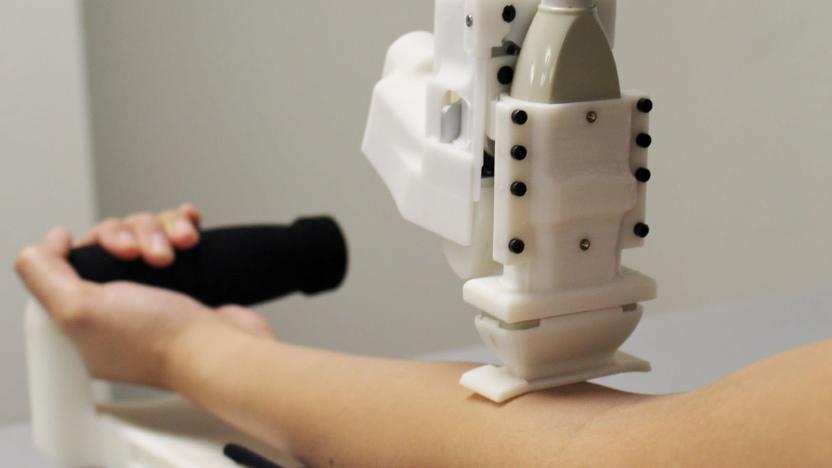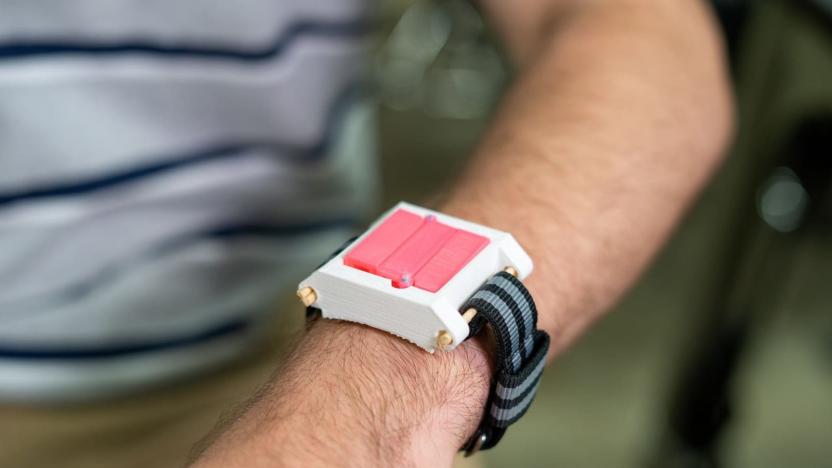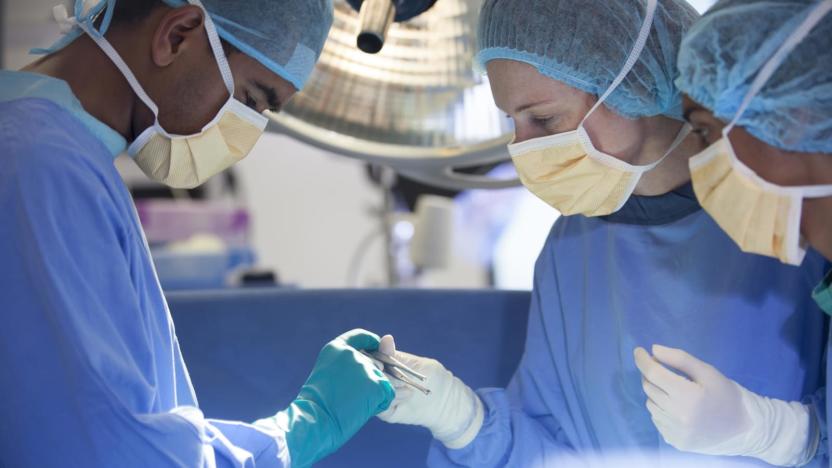needle
Latest

Blood-drawing robot is supposedly more accurate than humans
The only thing worse than getting a needle is getting two (or more) when the first jab attempt fails. Now, researchers from Rutgers and Mount Sinai Hospital have developed a robot that can see under your skin and supposedly do the job better than humans. That could one day help reduce problems like infections and thrombosis when attempting to start an IV line, for example.

Syringe 'watch' puts a life-saving allergy shot on your wrist
If you're prone to serious allergic reactions, carrying an epinephrine shot (such as an EpiPen) could be vital. Those shots are often bulky, though, and there's a real chance you could lose yours right before you need it. Students at Rice University have a (relatively) simple solution: put the shot on your wrist. They've developed a wearable, the EpiWear, that hides a foldable epinephrine syringe in a device not much larger than a watch. If you're in an emergency, you just need to unfold it, flick a safety lever and push a button when you're ready to inject the medicine into your thigh.

Researchers create ultrasound needle for internal surgical images
Minimally invasive surgeries are appealing because they typically mean less scar tissue, shorter recovery times and a lower risk of infection. But they have their downsides as well. Getting a good look at the tissue being targeted during a minimally invasive surgery can be quite difficult, and often surgeons are limited to using external ultrasound probes and imaging scans taken prior to surgery. But new research published today in Light: Science & Applications presents a potential new option -- an optical ultrasound needle.

Robopsy is a low-cost, disposable patient-mounted medical robot
In a less gelatin-centric demo, the Harvard-based team behind the Robotically Steerable Probe showed off some Robopsy devices during our visit to the school, rings that can help medical imaging technology like CT, ultrasound and MR physically pinpoint precise locations on patients. The devices, which can hold up to ten needles, are lightweight, mounting directly on patients via adhesives or straps. The medical robots are made largely of inexpensive injection molded plastic parts, making them disposable after they've been used on a patient, popping the motors and other control electronics onto another device. In all, the team says Robopsy rings are "orders of magnitude" cheaper and lighter than other medical robotic devices. Check out a video of the one of the Robopsy devices running after the break.%Gallery-161787%

Robotically Steerable Probe aims at minimally invasive surgery, moves through gelatin like a champ
Who doesn't prefer to have the word "surgery" preceded by the phrase "minimally invasive?" During our trip to the Harvard research labs today, we were given a demo of the Robotically Steerable Thermal Ablation Probe, a device designed to help minimize the number of injections required when treating something like a tumor. The machine is guided by a x-ray image onto which a doctor can choose a number of destinations. Rather than being forced to re-inject the patient, the outer cannula moves up and down to locate the position, with a thinner curved stylet extends from within it, reaching the designated area. In order to hit subsequent spots, the stylet retracts back into the cannula, which adjusts its up and down position, extending once again to reach the area. Applications for the technology extend beyond just injection, including the possibility of extracting tissue samples from a patient. You can check out a demo of the device doing its work after the break. But don't worry, it's just gelatine.

MIT's needleless injections help you get drugs faster, doesn't even hurt (video)
Afraid of needles? You may not have to be if a team of MIT scientists get their way. Researchers in the Department of Mechanical Engineering are developing a jet-injection device (similar to this one) that allows professionals to pump you full of meds without poking you with a needle. The key to puncture free pharmaceuticals is pressure -- the device uses a Lorenz Force actuator to push medicine out of an opening about the diameter of a mosquito's proboscis. The nozzle pulls liquids out just as fast and efficiently as it administers them, researchers say, and can even deliver powder-based drugs as if they were a liquid, thanks to a bit of supersonic trickery. This tech could be a boon to healthcare workers who get pricked on the job or patients who get daily insulin shots. Promises of painless inoculations piquing your interest? Hit the video after the break to see how its done.

Newfangled lab-on-a-chip technology gets more health data from less blood
It's a nightmare of epic proportions: the finger prick. Anyone who detests 'em completely understands, and they'll also be supremely appreciative of the work being done by Dr. Karan Kaler and co. at the University of Calgary. Kaler's team has created a new lab-on-a-chip technology, which uses a wireless microchip to analyze nanolitre-sized samples of blood. That's far less fluid than is currently needed to run a gauntlet of tests, and this fresh take is also far more efficient. We're told that it "involves creating a structure called a micro-emulsion, which is a droplet of fluid captured inside a layer of another substance." From there, the emulsions are positioned precisely on the chip, and after tests are ran, the results are piped wirelessly to a computer. The potential here is far more impressive than the existing iteration; the long-term vision is to "create handheld devices for patients to use at home for testing fluids, such as blood and urine," which would prevent extensive wait times and enable patients to get vital information faster. There's no telling how long it'll take to escape the lab and land in the hands of those who need it, but we're sure the folks involved are cranking just as hard as they can.

Vaccine-delivery patch uses microneedles to do its dirty work, looks good in testing
This dissolving microneedle patch has been in development for well over a year now, but Mark Prausnitz -- a professor in the Georgia Tech School of Chemical and Biomolecular Engineering -- along with a number of other GT and Emory University colleagues, have just now wrapped up a lab trial that brings it that much closer to market. As the story goes, this vaccine-delivery patch, which is based on hundreds of microscopic needles that dissolve into the skin, was recently seen as reliable in a round of mice tests, and the powers that be have also concluded that these patches would cost "cost about the same as conventional needle-and-syringe techniques, and may lower the overall cost of immunization programs by reducing personnel costs and waste disposal requirements." Oh, and did we mention that you could apply 'em on your own with little to no pain? FDA approval, we're waitin' on ya.

Robot surgeon uses frighteningly large needle to remove shrapnel, your resistance
We've reported on many a creepy looking and dangerous sounding robot in the past, but this one might just take the cake when it comes to dominating your nightmares for the next few nights. Developed by a team at Duke University, the bot uses ultrasound to identify areas of density in human flesh, then starts probing them with a rather painfully large looking needle. It could be used to locate and extract bits of shrapnel from stricken GIs on the battlefield, but that same tech might also be deployed to pierce women's breasts and men's prostates -- ostensibly to treat cancers of those respective regions, but we can think of more nefarious reasons. The bot doesn't have a name, but once it and its kind take over, neither will you. [Via gizmag]

Venus wearable monitor could offer alternative to needles
It looks like folks wary of needles now have yet another piece of technology to look forward to, with this so-called Venus device promising to measure tissue oxygen and pH levels without the need to draw any blood at all. To do that, the system makes use of a relatively small sensor that's placed directly on the skin, which uses near infrared light to measure to measure the blood and analyze both the tissue oxygen and pH, as well as the the metabolic rate. As a bonus, the lack of needles also reduces the the risk of infection, and it's relatively portable nature makes it ideal for use outside of strictly medical situations, such as monitoring athletes -- or astronauts, as it was originally developed for. As you might expect, however, the device is still just in prototype form, and there doesn't appear to be any indication as to when it might move beyond the lab.

Ceramic microneedles to make injections painless
Rest assured, we've "seen" methods of delivering injections sans pain, but we've yet to actually experience this phenomenon ourselves. If Dr. Roger Narayan has anything to do about it, however, we may not feel even a pinch the next time the blood drive comes calling. A team of researchers led by the aforementioned individual has reportedly been able to use "two-photon polymerization of organically modified ceramic (Ormocer) hybrid materials to create microneedles resistant to breakage," and they can also be made in a wider range of sizes than metal counterparts. It's said that these very needles would be "so fine that patients wouldn't feel them piercing their skin," and while that sure sounds delightful, we've no idea how many more visits we'll make before finding one of these in the nurse's hand.[Via medGadget, image courtesy of Rice]

Eli Lilly offering up undercover insulin pen to US
There's already a bevy of devices out there designed to keep track and manage one's diabetes and glucose levels, but Eli Lilly's innocuous pen-like injector looks to make the process of taking insulin a bit less invasive. The Huma-Pen Memoir resembles your average ink pen and shouldn't look too out of place holding it down in your tee's front pocket, but whenever you need a shot of insulin, it conveniently turns into an injector thanks to the hidden hypodermic needle encased within. The device also "allows the user to dial the amount of insulin they need to take," and keeps the dosage, date, and time of the previous 16 shots in order to keep diabetics from overdosing. Users should be able to utilize the same pen for "around three years," and after a needle is used, another is inserted and ready to go at the owners request. A few lucky participants have already received their pen here in the US, and while this nifty invention has been available across Europe for some time now, it will officially hit American retail shelves next week for around $45.[Via MedGadget]







